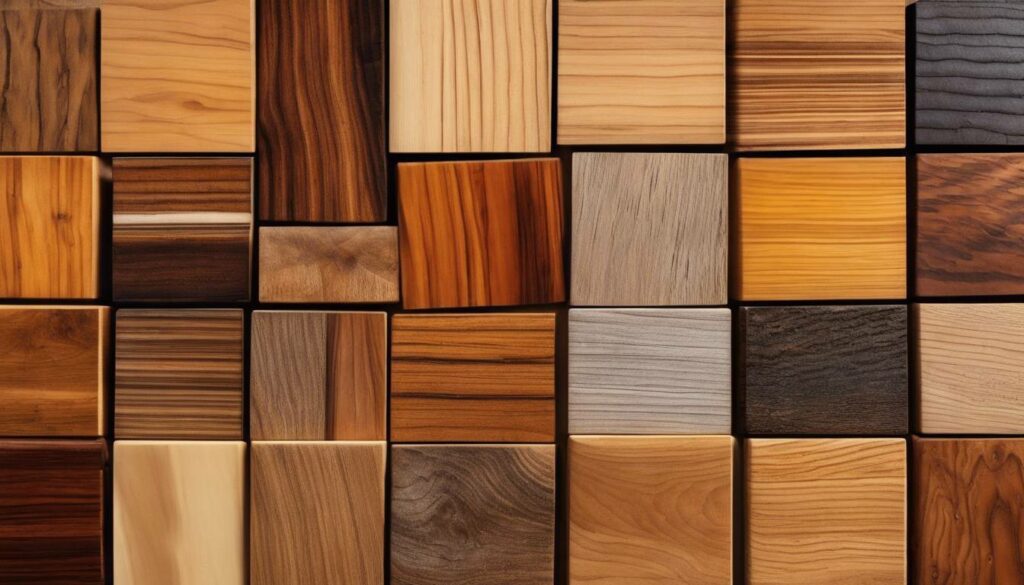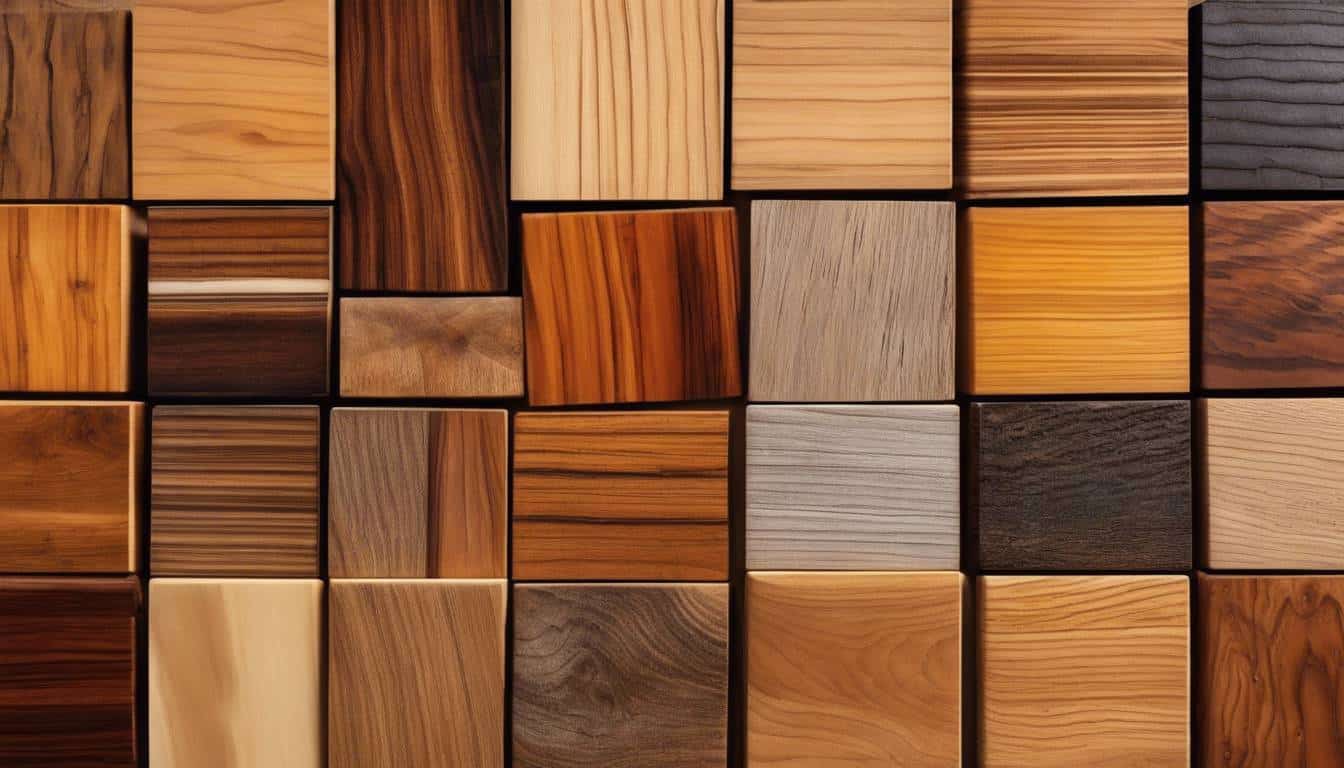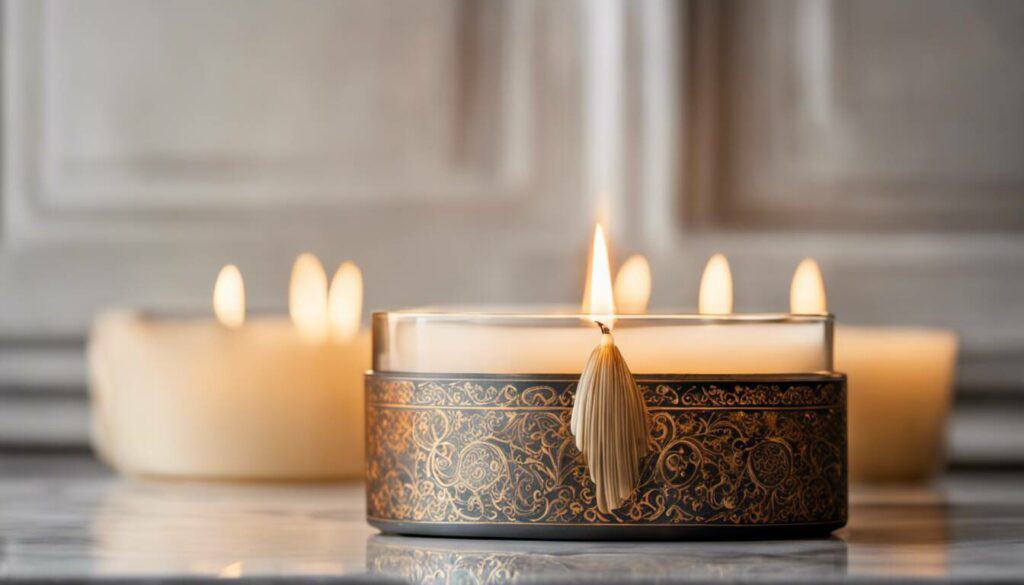The wood hardness scale is an essential guide determining a wood’s resistance to wear and denting. This measurement, commonly gathered through the Janka hardness test, acts as an indicator helping industries like flooring and furniture make the right wood choices. Surprisingly, this system hasn’t always been around but its creation has made it significantly easier for anyone from professional artisans to DIY enthusiasts to pick their perfect piece of timber. So next time you’re selecting wood, don’t forget that hardness matters!
The Wood Hardness Scale, measured using the Janka Hardness Test, provides a numerical value indicating a wood species’ resistance to wear and denting. This scale assists in selecting the appropriate wood for specific uses; for example, harder woods like Brazilian Cherry (Janka hardness of 2350 lbs) are excellent choices for high-traffic flooring, while softer woods like Pine (Janka hardness of 690 lbs) may be better suited for decorative furniture.
Wood Hardness Scale Overview
The wood hardness scale, specifically gauged through the Janka hardness test, evaluates how well different wood species can withstand dents and wear. It’s a crucial metric predominantly utilized in the flooring and furniture industries to ascertain the appropriateness of a specific type of wood for distinct applications.
The Janka hardness test involves driving a steel ball into the wood sample with force, measuring the pressure required to embed it up to a predetermined depth. The higher the Janka hardness value, the harder the wood is considered to be. This parameter is expressed in pounds-force (lbf) in the United States and is instrumental in discerning the durability and suitability of various wood species across diverse woodworking projects.
For instance, if you’re considering hardwood flooring for high-traffic areas like hallways or kitchens, opting for a wood species with a high Janka rating ensures its resilience against impact and wear. Conversely, softer woods may be more suitable for decorative or low-traffic projects due to their natural beauty and workability.
It’s worth noting that while Janka hardness values provide valuable insights into wood durability, this metric doesn’t account for other essential qualities such as dimensional stability, ease of finishing, or resistance to decay. Therefore, it’s imperative to consider a holistic range of characteristics when selecting wood for specific applications.
Understanding how each wood species varies in terms of hardness empowers craftsmen and enthusiasts alike to make informed decisions about their woodworking projects. In our subsequent sections, we’ll explore specific wood species and their corresponding Janka hardness ratings, shedding light on their practical applications across different sectors within the woodworking industry.
Understanding Hardness Determination
The Janka Hardness Test is a widely used method to measure the hardness of wood. But how exactly is this done? To determine a wood’s Janka rating, a small steel ball is used to apply pressure and measure the force required to embed it into the wood to a specific depth. This depth corresponds to half the diameter of the steel ball, ensuring a consistent and accurate measurement.
It’s an interesting process to picture. Imagine pressing a tiny steel ball into wood – it takes quite a bit of force to press it halfway in, doesn’t it? This test is all about gauging that force. The greater the force required, the higher the Janka rating, signifying a harder wood. Conversely, lower force indicates a softer wood, as indicated by its lower Janka rating.
Take Brazilian Cherry, for example, with an impressive Janka rating of 2820 lbs. Its dense nature makes it suitable for high-traffic areas. In contrast, Eastern White Pine stands at 380 lbs on the Janka scale, indicating its softer nature makes it suitable for high-traffic areas. In contrast, Eastern White Pine stands at 380 lbs on the Janka scale, indicating its softer nature. This contrast highlights how different woods offer varying levels of durability and resistance to wear and tear.
So, what are we trying to achieve here? We’re looking for woods that can withstand pressure, whether from foot traffic or furniture weight. The Janka rating helps us identify which types of wood are best suited for specific applications. When choosing flooring or furniture materials, this knowledge becomes invaluable in ensuring longevity and durability.
But here’s something crucial: don’t be misled by thinking that harder always equals better. It’s all about choosing the right wood for the job. For instance, while a hard hardwood might be perfect for flooring because it can stand up to foot traffic and resist wear, it might be too heavy and unyielding for intricate woodworking projects that require flexibility.
Understanding how wood hardness is determined not only enlightens us about the Janka test procedure but also aids in making informed choices when selecting wood for various applications.
Equipped with this understanding of wood hardness and its significance in selecting suitable materials, let’s now shift our focus to exploring the key criteria that play into determining wood hardness.
Key Criteria for Wood Hardness
When it comes to evaluating wood hardness, several key factors play a crucial role in determining the suitability of different wood types for various applications. Let’s explore these important criteria to gain a comprehensive understanding.
Wood Species
Each wood species holds its own unique characteristics, including varying levels of hardness. For instance, tropical hardwoods like Brazilian Walnut and Brazilian Cherry are known for their exceptional hardness, making them well-suited for high-traffic areas in flooring applications. On the other hand, softer wood species like Pine are better suited for decorative applications due to their workability and ease of staining.
Grain Orientation
The direction of the wood grain significantly impacts its hardness. Woods with straight grains are generally more dimensionally stable and thus tend to exhibit greater hardness compared to those with irregular or complex grain patterns. Moreover, quartersawn lumber is known for its increased stability and resistance to warping, often displaying higher hardness due to the orientation of the growth rings.
Moisture Content
The moisture level present in wood also influences its hardness. Drier wood tends to be harder as the absence of moisture reduces the flexibility and resilience of the cell walls. Conversely, higher moisture content can lead to softer wood, which may cause issues in applications where durability is essential.
As we consider these key criteria, it’s evident that different wood types exhibit varying levels of hardness based on factors such as their species, grain orientation, and moisture content—a critical consideration when selecting woods for specific purposes, ensuring they align with the intended application’s durability and wear resistance requirements.
In understanding how these criteria contribute to the overall hardness of various wood species, we can now shift our focus to compare the hardness levels between hardwoods and softwoods.
Hardwood and Softwood: Comparative Hardness
The terms “hardwood” and “softwood” aren’t just about how hard or soft the wood feels to the touch. As the names suggest, hardwood usually comes from deciduous trees like oak, maple, or cherry, while softwood usually comes from coniferous trees like pine, cedar, or fir. But what really sets them apart is their Janka hardness ratings.
Hardwoods generally have a higher Janka hardness rating, which means they’re harder and more durable compared to softwoods. This makes them well-suited for applications where durability and strength are crucial, such as in furniture making, flooring, and heavy construction. On the other hand, softwoods tend to have lower Janka hardness values compared to hardwoods. This means they are typically used in applications where extreme hardness isn’t required, like in outdoor construction, paper manufacturing, and general carpentry.
For instance, if you’re looking to build a sturdy dining table that’s likely to withstand heavy daily use without getting easily scratched or dented, hardwoods like oak or walnut would be an excellent choice due to their superior hardness. Conversely, if you’re aiming to construct a garden shed or deck where natural resistance to decay and insect infestation is of primary importance, a softwood variety like cedar or redwood might be more suitable for the job due to its inherent properties.
The distinction between hardwoods and softwoods goes beyond just their physical properties; it extends into aesthetics as well.
Aesthetics and Grain
Hardwoods often boast beautiful grain patterns and colors, making them highly sought after for decorative purposes in furniture and cabinetry. Their intricate grain patterns add character to the finished product. In contrast, while softwoods may not feature the same level of intricate grain detail as hardwoods, they possess a certain rustic charm that complements various architectural styles.
Consider furniture crafted from hardwoods like mahogany or cherry – their rich hues shine through and accentuate the individuality of each piece. Similarly, softwoods such as pine with its knotty texture can be utilized to create a cozy country cottage feel.
Ultimately, the choice between hardwood and softwood revolves around striking a balance between durability, aesthetic appeal, and intended application. While hardwoods excel in strength and resilience, softwoods offer versatility and an understated beauty that shouldn’t be overlooked.
Understanding the differences between these two wood categories allows for informed decision-making when selecting materials for specific projects—ensuring that each piece benefits from the unique characteristics of both hardwoods and softwoods.
Janka Scale and Wood Classification
The Janka hardness test measures the resistance of a wood sample to denting and wear. This scale is crucial in wood classification and provides a comprehensive chart of various wood species alongside their corresponding Janka hardness values, expressed in pounds-force (lbf). It assists consumers in understanding the relative hardness of different woods, aiding in the selection of the right wood for a particular application.
Consider the vast difference in hardness between Brazilian Walnut with a Janka rating of 3680 lbf and Douglas Fir with a rating of 660 lbf. This stark contrast underscores the importance of considering Janka hardness values when selecting wood for specific applications.
When choosing wood for flooring, furniture, or other areas where durability is paramount, referring to the Janka hardness scale can provide valuable insights. It guides consumers in determining which wood species are more suitable for high-traffic areas, heavy-duty furniture, or intricate woodworking projects.
The Janka scale originated from the need to assess the suitability of different wood species for use in flooring installations. The test measures the force required to embed an 11.28 millimeter steel ball halfway into a sample of wood, determining its hardness based on this indentation.
Understanding the Janka scale enables consumers and industry professionals to make informed decisions about which wood species will hold up best in different applications. For instance, if you were considering building a deck or outdoor furniture, you might seek out woods with higher Janka ratings and greater resistance to wear and tear, such as ash or oak.
Having established the significance of the Janka scale in understanding wood hardness, let’s delve further into how this knowledge influences material selection for various woodworking and construction projects.
Practical Applications of Wood Hardness
Flooring Selection
When choosing the right wood for flooring, understanding the Janka hardness of different wood species becomes crucial. A higher Janka hardness rating signifies greater resistance to wear, making it particularly suitable for high-traffic areas like hallways, kitchens, and living rooms. For instance, woods like Brazilian Cherry and Hickory are popular choices due to their exceptional hardness. Conversely, in lower traffic areas such as bedrooms or studies, a less hard wood could be sufficient. This not only ensures durability but also minimizes maintenance costs in the long run.
Hardwood floors are an investment that can last for generations if properly maintained. It is important to choose a wood species that aligns with your specific needs and lifestyle. For example, if you have kids or pets at home, selecting a harder wood species would be beneficial as it can withstand greater impact and resist scratches better than softer woods.
Furniture Production
In the realm of furniture production, the Janka hardness scale is an essential tool used by manufacturers to select appropriate wood types for crafting durable, long-lasting products. Harder woods like oak, maple, and cherry are often preferred for crafting furniture pieces that require strength and resilience against daily wear and tear. The ability of these hardwoods to withstand pressure makes them ideal for constructing dining tables, chairs, and cabinets that are built to withstand the test of time.
Additionally, beyond mere hardness, factors such as dimensional stability and shrinkage play a pivotal role in the selection process. Woods that are more dimensionally stable are less likely to warp or change shape due to fluctuations in temperature and humidity, making them favored choices for furniture production.
Woodworkers and furniture craftsmen understand that choosing the right wood species isn’t just about strength but also about its ability to resist changes caused by environmental factors.
For instance, a coffee table made from a softer wood like pine may succumb to dents and scratches more easily than one made from a harder wood like oak or mahogany. Therefore, understanding the Janka hardness of wood is not only beneficial for ensuring longevity but also for maintaining the aesthetic appeal of furniture pieces over time.
The practical implications of considering Janka hardness in these contexts highlight how this measure goes beyond just numerical ratings. It’s a key consideration in ensuring longevity and quality across various applications within the world of woodworking and construction.
Understanding the practical implications of wood hardness provides valuable insights into its impact on everyday items and structures. In the next section, we’ll explore the direct benefits of comprehending the Janka Scale in real-world scenarios.
Benefits of Understanding the Janka Scale
Understanding the Janka Scale isn’t just about knowing the hardness of a piece of wood; it offers a wealth of benefits that can inform and impact your decisions when it comes to woodworking, construction, and interior design. Let’s take a closer look at why this knowledge is so valuable.
Durability Assessment
By understanding the Janka hardness of different wood species, you gain insight into their durability and suitability for various applications. This empowers you to make well-informed decisions when choosing materials for furniture, flooring, and other projects. For example, if you’re looking to install hardwood floors in a high-traffic area, selecting a wood with a high Janka hardness rating can help ensure its longevity and resistance to wear and tear. On the other hand, for decorative elements that may not undergo heavy use, a lower Janka rating might suffice. The ability to assess durability based on this scale allows for smarter choices that align with specific project needs, leading to the creation of enduring and resilient wood-based products.
Informed Decision-Making
The Janka hardness scale equips consumers with valuable information to make informed decisions when selecting wood for specific projects. Rather than relying on guesswork or generic recommendations, understanding the Janka rating enables you to tailor your choices to the unique requirements of your endeavors. Whether you’re crafting custom furniture pieces, renovating interior spaces, or embarking on woodworking projects, having an awareness of wood hardness helps align material selection with performance expectations. This leads to greater satisfaction with end results and enhances the longevity and resilience of wood-based products, adding value to both functional and aesthetic aspects of your creations.
For instance, suppose you’re considering using a particular type of wood for exterior decking exposed to harsh weather conditions. With knowledge of the Janka hardness rating, you can confidently identify woods that are better equipped to withstand outdoor elements, such as moisture and temperature fluctuations. This targeted decision-making minimizes the risk of premature deterioration due to environmental factors, ensuring that the chosen wood species can effectively meet the demands imposed by its intended application.
In essence, understanding the Janka hardness scale grants you invaluable insights that guide your selection of wood for various projects, encompassing considerations of durability, resilience, and long-term performance.
The understanding of the Janka hardness scale not only raises the standard for informed decision-making but also elevates the quality and suitability of wood chosen for diverse applications. As you delve deeper into these principles, a newfound confidence in selecting and utilizing wood will undoubtedly enhance your woodworking pursuits.






